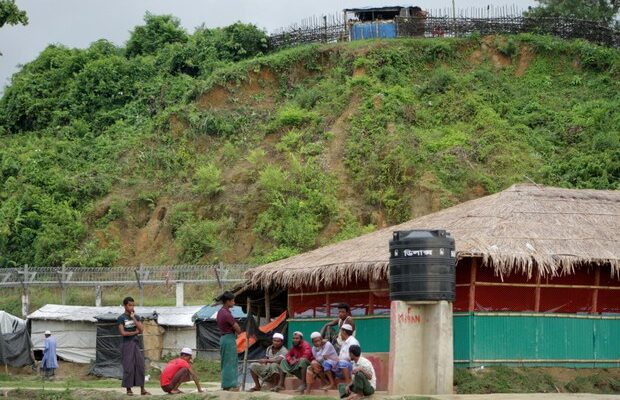The Rohingyas in No Man’s Land have fled to Bangladesh
After the latest genocide in August 2017 more than 700,000 Rohingyas fled to Bangladesh from Myanmar. However, since then around 6,000 Rohingyas who could not flee or who were not interested to go to Bangladesh have been stranded in no man’s land on the Myanmar-Bangladesh border. Rohingyas are the ethnic religious minority group who have been living in Rakhine state of Myanmar for centuries though Myanmar authorities still do not recognise their citizenship. Rohingyas lost their citizenship rights in Myanmar through the apartheid-like Citizenship act of 1982 and since then they are stateless in their motherland. Since 1962 when for the first time the military took over the power of then Burma (now Myanmar), the state-sponsored violence, systematic persecution and massive human rights violations forcibly them to cross the border and take shelter in neighbouring countries. This still goes on.
No man’s land between Bangladesh-Myanmar border
A no man’s land may be the space on a battlefield between two opposing front lines, a buffer zone between two countries or a piece of land unclaimed and ungoverned by local authorities. Bangladesh and Myanmar also have a no man’s land (an ill-defined area) situated near the Bandarban district of the Bangladesh-Myanmar border. This no man’s land is a small strip of land at Bandarban’s Tombru Bazar border area about 45km (28 miles) from Cox’s Bazar and is separated from Bangladesh by a small canal. This no man’s land is also known as ‘Zero Point’, between Myanmar and Bangladesh border, located adjacent to the Naikhyanchhari upazila of the Bandarban hill district area in Bangladesh (see picture).
History of Rohingyas sheltering in no man’s land
After the August 2017 brutal crackdown against Rohingyas in Rakhine state of Myanmar some thousands of Rohingyas crossed the Myanmar border and took shelter in no man’s land. They were the first group to flee from Myanmar before Bangladesh agreed to let the Rohingyas onto its soil. After the 2017 incident, more than 700,000 Rohingyas took shelter in 33 makeshift camps in Cox’s Bazar, Bangladesh and some 6,000 have been living in no man’s land at the Bangladesh-Myanmar border. After taking shelter at no man’s land these Rohingya people reiterated that they will not leave this land until their rights to be ensured. In September 2022, the stranded Rohingyas of no man’s land appealed to the UN to take measures for their protection and safe return to Myanmar’s Rakhine State. However, the Myanmar authorities always tried to push these Rohingyas into Bangladesh territory.
Leaving no man’s land after continuous threats from Myanmar
After taking shelter in no man’s land the Rohingya people were continuously threatened by the Myanmar authorities. Authorities claimed that the no man’s land area was within their territory and tried to push Rohingyas from the area. Various land mines were also planted by the Myanmar authorities along the border and also near the no man’s land area that created a dangerous situation. The Myanmar security forces even used loudspeakers to order the stranded Rohingyas to leave the area immediately and cross into Bangladesh. Mortar shells were launched from the Myanmar side at the no man’s land area several times that killed and injured Rohingyas. Being scared and afraid, some Rohingya families left the no man’s land area in 2018 and took shelter in Bangladesh. After thousands fled from no man’s land in 2018, only roughly 2,500-3,000 Rohingya people remained in the area.
Rohingyas have vacated No Man’s Land
In 2023 there were around 4,000 Rohingyas still living in no man’s land and facing so many obstacles. At the start of the new year conflict and fighting between two rival groups of Rohingyas took a fatal turn. Though fighting went on for several days, the local administration in Bangladesh could not confirm the incident as they do not have authority in no man’s land. The Rohingya refugees who got shelter in Bangladesh mentioned to local journalists that the fight erupted between the Arakan Rohingya Salvation Army (ARSA) and the Rohingya Solidarity Organisation (RSO) (ARSA- RSO conflict). On 18 January 2023, the bloody clashes between the ARSA and RSO resulted in the killing of one Rohingya and the injuring of several others. After the gunfight between the two armed Rohingya insurgent groups panic gripped the common Rohingyas staying in no man’s land and they started to flee.
On 18 January 2023, all the refugee settlements made up of polythene, bamboo etc. in no man’s land were burnt to the ground after an hours-long gunfight. As a result, all the Rohingyas who were staying in the no man’s land camp have fled and taken shelter across the border in Bangladesh.
Displaced Rohingyas now inside Bangladesh
Displaced Rohingyas who fled from the no man’s land due to the recent bloody clashes, are now staying under the open sky inside Bangladesh. However, they are now looked after by Border Guard Bangladesh (BGB), police, and other concerned local officials as they are inside Bangladeshi territory. These persecuted people urgently need shelter, food, medicine, and other basic things. When they were in no man’s land they were only looked after by the Red Cross and Bangladesh Red Crescent Society as they were not declared as refugees or Forcibly Displaced Myanmar Nationals- FDMN (the label used by Bangladesh government For the Rohingyas who are now staying in the 33 camps at Cox’s Bazar, Bangladesh).
Bangladesh declared several times that no more Rohingyas will be accepted as this country is hosting more than 1.2 million Rohingyas since the latest genocide occurred against them in August 2017. However, the country has accepted more than 4,000 new Rohingyas who were formerly in no man’s land. Abdul Ali (70), a Rohingya who moved to the open field shelter in Bangladesh after the blaze engulfed his tent in the no-man’s land, told Anadolu Agency: “Is the world not able to find a sustainable solution to our crisis? Will our next generation also face the same plight?”

